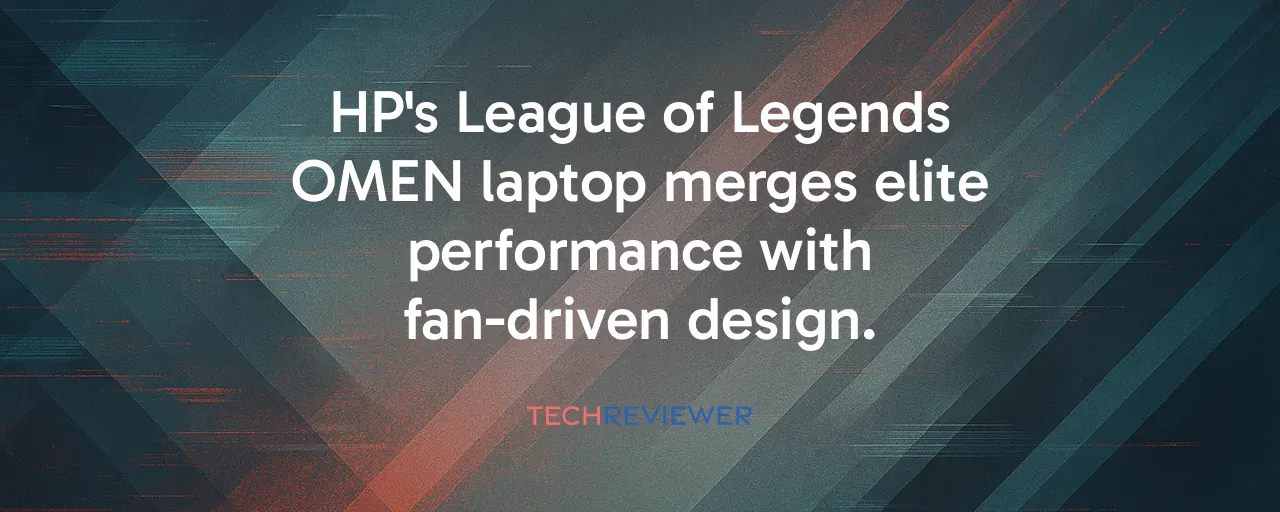A Laptop Built for Summoner's Rift
HP's latest OMEN 16 League of Legends Limited Edition laptop, unveiled at the 2025 League of Legends World Championship in Chengdu, China, feels like it was forged in the heart of Summoner's Rift. This isn't just another gaming laptop; it's a love letter to the game's 117-135 million monthly players. With Intel Core i7-14650HX processors and NVIDIA's RTX 5070 GPU packing 8GB of cutting-edge GDDR7 VRAM, it delivers the kind of performance that keeps up with fast-paced team fights. The laptop's design screams League pride, from hextech-inspired keycaps to gold accents and a webcam slider etched with ward graphics. For players who live and breathe the game, this machine is a badge of honor.
The timing of the launch, right in the thick of Worlds 2025, taps into the electric energy of esports' biggest stage. HP's collaboration with Riot Games, which began in 2024, goes beyond slapping a logo on a laptop. It's about crafting hardware that resonates with a community where competitive performance and cultural identity collide. The $1,999.99 price tag puts it in premium territory, but for dedicated players, the blend of power and fandom makes it a compelling choice.
Performance That Matches Pro-Level Play
Under the hood, the OMEN 16 is a beast built for esports dominance. Its RTX 5070 GPU, with 7,680 CUDA cores and fourth-generation ray-tracing cores, pushes frame rates above 144 FPS, even during chaotic League of Legends matches. The Intel i7-14650HX, with 16 cores and a 5.2 GHz boost, handles multitasking without breaking a sweat, enabling tasks such as streaming on OBS, chatting on Discord, and browsing build guides, all while maintaining silky-smooth gameplay. The 32GB DDR5-5600 RAM and 1TB PCIe Gen4 SSD ensure lightning-fast load times, giving players an edge in champ select.
HP didn't skimp on cooling either. With wider fan gaps and extra heat pipes, the laptop stays quiet and cool under pressure, addressing a common pain point for gamers who've endured roaring fans. The OMEN AI software takes it a step further, tweaking performance settings on the fly for maximum power or battery efficiency. Whether you're grinding ranked matches or competing in a local tournament, this machine keeps up without compromise. Still, some players argue desktops offer better value for similar specs, with 30-40% lower costs for equivalent performance. The OMEN 16 counters with portability, weighing 2.43kg, making it a solid pick for LAN parties or collegiate esports.
Why Esports Partnerships Are Redefining Hardware
HP's move with the OMEN 16 reflects a broader shift in the gaming industry, where hardware brands are diving deep into esports culture. The global esports market hit $2.4 billion in 2024 and is projected to reach $12.68 billion by 2033, fueled by massive audiences, with projections reaching 640.8 million viewers by 2025. Companies like HP are capitalizing on this by launching products at high-visibility events like Worlds, where millions tune in. This isn't new; ASUS ROG's partnership with PlayVS equips 900 college campuses with gaming PCs, building loyalty among students. Lenovo Legion, meanwhile, powers the 2025 Esports World Cup with its Tower systems, focusing on pro-level exposure over consumer flash.
What sets HP's approach apart is its focus on fan-driven design. The OMEN 16's QWERDF key highlights and League-specific RGB lighting aren't just cosmetic; they reinforce muscle memory for critical abilities. Compare that to ASUS, which prioritizes institutional reach, or Lenovo, which bets on tournament prestige. HP's strategy banks on emotional connection, appealing to players who see League as a lifestyle. The downside? Limited editions like this can spark frustration when stock runs dry, and the $2,000 price may alienate younger fans, especially the 25% of players aged 18-20 with tighter budgets.
Lessons From the Esports Hardware Race
Looking at other partnerships offers insight into what works and what doesn't. ASUS ROG's PlayVS deal shows how targeting colleges can plant seeds for long-term brand loyalty. By equipping campuses, ASUS reaches young adults who'll likely stick with the brand post-graduation. But it's less about fan passion and more about practical exposure. Lenovo's Esports World Cup partnership, on the other hand, leans on pro players using its gear in high-stakes settings, influencing fans who idolize them. Research shows 40% of 18-34-year-olds buy gear based on pro endorsements, so this approach has teeth. Yet, it risks missing the personal connection HP nails with its League-themed design.
HP's challenge is balancing exclusivity with accessibility. The OMEN 16's limited run creates buzz but also FOMO, which can backfire if fans can't snag one. Past limited editions, like Razer's Blade 16 Lamborghini model, saw huge online hype but sluggish sales at $4,000, suggesting price and availability matter as much as design. HP's direct-to-consumer sales through its website help control distribution but limit hands-on access, unlike retail partnerships that let buyers test before committing. The lesson? Authenticity and community resonance drive success, but only if the price and supply align with demand.
What's Next for Gaming Hardware Collaborations
The OMEN 16 is just one piece of HP's growing Riot Games partnership, following the OMEN 35L VALORANT desktop launch in September 2025. With Riot's portfolio spanning VALORANT, Teamfight Tactics, and the upcoming Project L, there's room for more hardware tied to these worlds. The gaming laptop market, valued at $16.25 billion in 2024 and projected to hit $36.09 billion by 2033, thrives on these collaborations. As AI integration grows, with smarter performance tuning or predictive graphics settings, laptops like the OMEN 16 will keep pushing boundaries.
Still, challenges loom. Sustainability concerns are real, with limited editions fueling overconsumption and e-waste. HP could counter this with trade-in programs or modular designs, letting players upgrade components without ditching the chassis. Privacy is another hurdle; OMEN AI's telemetry needs clear user consent to avoid backlash. Looking ahead, deeper collaborations, such as co-developing hardware with pro players or funding amateur tournaments, could keep HP ahead in a crowded market. For now, the OMEN 16 stands as a bold step, blending esports performance with the heart of a gaming community.
